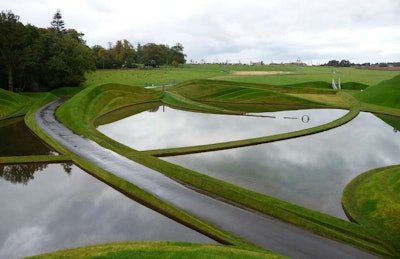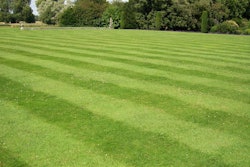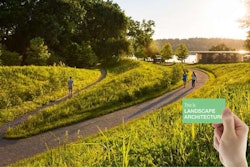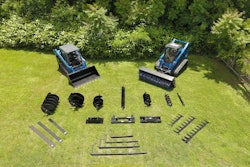 The theme of these landforms is the life of the cell and the way one cell divides into two. It can be found at Jupiter Artland in Edinburgh, Scotland.
The theme of these landforms is the life of the cell and the way one cell divides into two. It can be found at Jupiter Artland in Edinburgh, Scotland.Photo: John Lord/Flickr
Landscape architects often have to look at a much bigger picture when designing urban spaces, but landscape designer Charles Jencks takes that thinking one step further with his creations.
One of Jencks most notable works is actually at his own home and is known as The Garden of Cosmic Speculation. Jencks’ inspiration was the universe itself and he began the project as a site for symbolic exploration at the request of his wife, Maggie Keswick Jencks.
Spanning 30 acres in Dumfries, Scotland, The Garden of Cosmic Speculation features forty different areas that explore various metaphors, including a water cascade of steps that recounts the narrative of the universe and a series of landforms that hint at fractal geometry.
Jencks was born in Baltimore, Maryland, on June 21, 1939, and earned his Bachelor of Arts degree in English literature at Harvard and went on to earn a Master of Arts degree in architecture from the Harvard Graduate School of Design. He moved to the United Kingdom in 1965 and earned a Ph.D. in architectural history in 1970.
 The Cascading Universe is part of Jencks’ Garden of Cosmic Speculation.
The Cascading Universe is part of Jencks’ Garden of Cosmic Speculation.Photo: John Lord/Flickr
After his dive into landscape design in 1988, Jencks went on to create other landscapes based on science and math, and his designs are commonly inspired by genetics, chaos theory and solitons. His landforms often feature enigmatic writing and symbolism for visitors to discover on both the largest and smallest scale.
“To see the world in a Grain of Sand, the poetic insight of William Blake, is to find relationships between the big and small, science and spirituality, the universe and the landscape,” Jencks said on his website. “This cosmic setting provides the narrative for my content-driven work, the writing and the design. I explore metaphors that underlie both growing nature and the laws of nature, parallels that root us personally in the cosmos as firmly as a plant, even while our mind escapes this home.”
In Edinburg, Scotland, Jencks worked with Terry Farrell and Partners to create the Landform Ueda at the Gallery of Modern Art. It was designed to shield noise from the road while creating an “S” shape that is reminiscent of two chaotic attractors.
Another memorable design of Jencks’ is his contribution to the 2008 Olympic Forest Park in Beijing, China. Wu Chi evokes the sense of a black hole with its tilting tiles and visitors spill in on both sides toward a central rotating turntable, which furthers the illusion of a sucking vortex.
Jencks’ fascination with the cosmos and all that is in it also helps ensure his creativity never runs dry as there are always new theories about the universe being proposed. For example, in the early 2000s the multiverse theory was gaining ground with scientists and in response, Jencks began working on The Crawick Multiverse in 2010.
The land art was privately funded by the Duke of Buccleach and was completed in 2015. It was constructed from a former open-cast coal mine in Sanquhar and Kirkconnel, Scotland. It was primarily constructed from materials found on-site. Visitors can transverse the fifty-five acres and view metaphorical galaxies, comets and multiverses.
For more photos of Jencks’ projects, click here.










